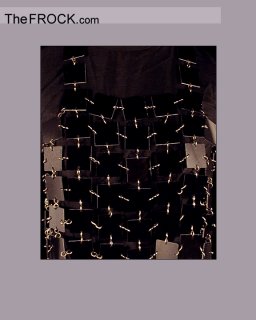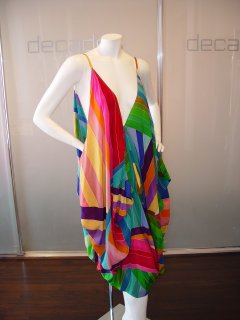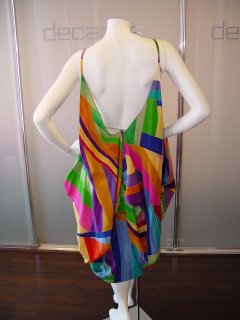Pre-FAB-rications: Innovative Fabrics of the 1960s
"I defy anyone to design a hat, coat or dress that hasn't been done before...The only new frontier left in fashion is the finding of new materials" - Paco Rabanne 1966
Although Paco Rabanne's sentiments were quite true, and fashion had already been repeating itself for some time, many garment manufacturers had already figured out the need for new fabrications. Manufacturers had begun using different materials in discount ready-to-wear fashion (which was a fairly new post-war concept). The garment industry had been looking for inexpensive ways to mass-manufacture easy-care clothing. At the same time this evolution in fabrications was taking place, radical changes in clothing style were also happening.
Plastic disc dresses, Life Magazine, July 7, 1968
Within 10 years, women's skirt hems went from below the knee, to just below the buttocks - or to the ankle. Men began to wear clothing which would have previously been designed only for women. All the rules had been turned upside down! Conventional fabrics began to be used in new and creative ways, but a courageous few turned to outrageous fabrications and began using paper, plastic, vinyl and metals for ready to wear fashion.
The increased speed of society in urban areas led to the development of easy-care fabrics such as polyesters. This invention led to wrinkle-free fabrics and a reduction in the time spent needed on clothing care.
The logical extension in easy care would obviously be "no-care", and so, the paper dress was born. These garments were inspired by industrial throwaway clothing used for many modern occupations such as hospital work. Printed in bright pop-art designs, the dresses quickly went from the runway to teen fad. Hallmark even adopted the idea for hostess party wear to match their paper goods! Paper dresses were fairly cheap, and could easily be altered with scissors. However convenient these dresses seemed, they offered little in the way of security. Daring wearers fastened dresses and short coulotte outfits with a few ties, and had to continually be on guard for rips or tears.
The next best thing to no-care fabrics is to just give them a good wipe. Vinyl affords this luxury, and while some manufacturers focused on paper, others were busy combining the chemicals to make poly vinyl chloride, or PVC. This was another fabric borrowed from industrial use and turned into wearable fabrics. Popular with teenage girls, vinyl was first made into sensible rain wear. Boots and raincoats soon inspired the adventurous to make wipe-down dresses, men's pull-overs, go-go boots, purses and any and every other kind of outer garment as PVC was easily colored and imprinted with wild designs.
Quite naturally, PVC led to alternative uses of plastics. Some of the most ingenious new designs were not only created for wearability, but also to appear "modern". Plastics had been melded into both polyesters and PVC, but had never before been used in their hard form except for buttons and decorations which were applied to other fabrics. Paco Rabanne is credited with the first use of hard plastics as garments. He strung together small shapes with wire and sometimes adorned with beads to create futuristic looking evening wear.
Soon discount manufacturers were pressing chunks of plastic into fabrics making texturized purses, and looping colorful shapes with large metal rings for simple belts. Even more innovative were the home crafting kits which combined hundreds of plastic discs, a spool of wire, needle-nose pliers and directions to do it all yourself!
Rabanne's garments were not necessarily practical, but were very showy and fun. Fashion had turned from being quite functional to often being mere adornment. Visually, the plastic clothing appeared similar to chain mail, and soon, designers were incorporating metal chain mail into late 60s Middle-Eastern inspired designs. Head wraps, vests and jewelry began to look similar to belly-dancer costumes.
Taking the sentiment of finding new fabrics even further, the adventurous Diana Dew created electric outfits which made spectacular stage wear for bands psychedelic groups like the Electric Prunes.
One of the most unique aspects of these unusual fabrications is their longevity. Plastic and metal will last for years to come, and paper garments, which were treated with plastic-like chemicals also seem to be quite easily found in excellent shape. The only problem is if PVC bonds to a garment containing cotton. PVC breaks down to release ethylene gases which destroy natural fibers and cause the bonding to become "gooey" and break. PVC is best stored in a garment bag away from other clothing.












 Part of the problem in finding images of his work online is because his name is often misspelled in tags. Arg - very frustrating. I have time today, and will dig around for more.
Part of the problem in finding images of his work online is because his name is often misspelled in tags. Arg - very frustrating. I have time today, and will dig around for more. 












